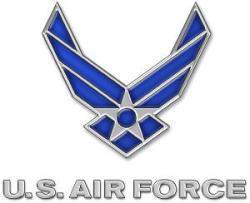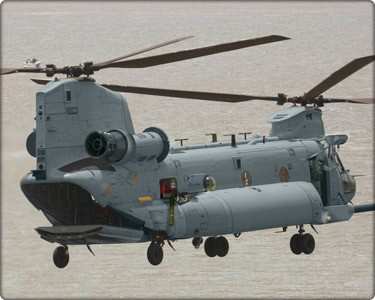Air Force Reviewing Bids For Contract
 Editor's Note:
Don Manuszewski, spokesman for the US Air Force, commented Friday
on ANN's story regarding the CSAR-X helicopter bid... which stated
internal documents, obtained by Reuters, show the Air Force
originally passed on the Boeing HH-47 as a combat search and rescue
helicopter in early phases of the bid. The HH-47 ultimately won the
CSAR-X contract last year.
Editor's Note:
Don Manuszewski, spokesman for the US Air Force, commented Friday
on ANN's story regarding the CSAR-X helicopter bid... which stated
internal documents, obtained by Reuters, show the Air Force
originally passed on the Boeing HH-47 as a combat search and rescue
helicopter in early phases of the bid. The HH-47 ultimately won the
CSAR-X contract last year.
Below, we offer Mr. Manuszewski's comments added to ANN's
original story.
Why did the US Air Force go with a heavier, louder, more costly
aircraft when it awarded a $15 billion contract to Boeing last
year? That's what many critics have asked since the Air Force
selected the twin-rotor HH-47 for its combat search and rescue
helicopter program, known as CSAR-X, last November.
AF COMMENT: The Air Force selected the best value;
individual cost, although a factor, is not the lone
factor. Additionally, the selected platform met or exceeded
all other factors in this capability based
acquisition.
Not surprisingly, the most vocal critics of the Air Force's
decision were the losing parties in that contract bid -- Sikorsky,
and Lockheed Martin. But others in the aviation community have said
the Chinook variant is the wrong choice for CSAR-X, as well. So has
Arizona Senator John McCain.
And, as it turns out, so did the US Air Force... several years
before it awarded the contract to Boeing. According to internal
documents obtained by Reuters, the Air Force initially ruled out
the Chinook for the contract.
AF COMMENT: The 2002 USAF Combat Rescue Analysis of
Alternatives (AoA) dropped the MH-47E from its analysis because the
contractor did not respond to the RFI and provided no data with
which the Study Team could work. The 2005 AoA Update to
the USAF Combat Rescue Analysis of Alternatives did not include or
exclude any material solutions in its reports. The 2005 AoA update
addressed four issues: 1) What Operational Environment
changes have occurred; 2) Do PRV and subsequent CSAR-X capability
requirements require modification; 3) Is the medium lift helicopter
concept selection still valid; 4) Are force structure changes
required.
 Among those documents is a 2002
analysis of alternatives (AOA), and a 2004 draft outline of
military needs. Both state the Boeing helicopter was
"considered, but discarded from complete analysis" for its
compatibility with the CSAR-X requirements for a medium-lift
helo.
Among those documents is a 2002
analysis of alternatives (AOA), and a 2004 draft outline of
military needs. Both state the Boeing helicopter was
"considered, but discarded from complete analysis" for its
compatibility with the CSAR-X requirements for a medium-lift
helo.
Additionally, sources familiar with the complete AOA document
told Reuters it contained a wealth of information on the other
CSAR-X entrants -- Sikorsky's H-92, and Lockheed's EH101 -- but
little on the twin-rotor HH-47.
So how did Boeing go from "discarded" to winner? Air Force
spokesman Don Manuszewski says the Boeing helicopter was dropped
from early consideration because Boeing had not shown any interest
in the CSAR-X contract at that point.
"It was procedural, more than anything else," he said.
AF COMMENT: What I said was -- The 2002 USAF Combat
Rescue Analysis of Alternatives (AoA) dropped the MH-47E from its
analysis because the contractor did not respond to the RFI and
provided no data with which the Study Team could work. The
2005 AoA Update to the USAF Combat Rescue Analysis of
Alternatives did not include or exclude any material solutions in
its reports. The 2005 AoA update addressed four issues: 1)
What Operational Environment changes have occurred; 2) Do PRV and
subsequent CSAR-X capability requirements require modification; 3)
Is the medium lift helicopter concept selection still valid; 4) Are
force structure changes required.
Still, there were enough questions about the Air Force's
selection process to attract the attention of the Government
Accountability Office, which recommended in February
the USAF take another look at the other two CSAR-X entrants.
AF Comment: The GAO involvement came from protests
by the companies that weren't selected, this statement indicates
the GAO took it upon themselves to look into the contract
award.

After initially stating it would hold firm to its decision, the
Air Force did an about-face in April, and agreed to reopen the
contract for bid.
AF COMMENT: The contract will not be
rebid. The original offerors will be allowed to submit
additional information concerning the Operations and Support costs
for the cost evaluation.
Defense analyst Loren Thompson says the rebid process should
open some eyes within the USAF.
"The Air Force seems so intent on defending its acquisition
practices, that it isn't really addressing the question of whether
it bought the right aircraft," said Thompson.
AF COMMENT: The journalist failed to mention that
Loren Thompson is a paid consultant to Lockheed Martin, one of the
companies that filed a protest.
 ANN's Daily Aero-Linx (04.30.25)
ANN's Daily Aero-Linx (04.30.25) ANN FAQ: Turn On Post Notifications
ANN FAQ: Turn On Post Notifications Classic Aero-TV: Agile Aeros Jeff Greason--Disruptive Aerospace Innovations
Classic Aero-TV: Agile Aeros Jeff Greason--Disruptive Aerospace Innovations Aero-News: Quote of the Day (04.30.25)
Aero-News: Quote of the Day (04.30.25) ANN's Daily Aero-Term (04.30.25): Expedite
ANN's Daily Aero-Term (04.30.25): Expedite





